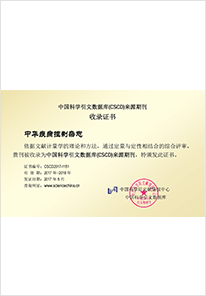2023 Vol. 27, No. 6
Display Method:
2023, 27(6): 621-626.
doi: 10.16462/j.cnki.zhjbkz.2023.06.001
Abstract:
2023, 27(6): 633-638.
doi: 10.16462/j.cnki.zhjbkz.2023.06.003
Abstract:
2023, 27(6): 639-644.
doi: 10.16462/j.cnki.zhjbkz.2023.06.004
Abstract:
2023, 27(6): 650-654.
doi: 10.16462/j.cnki.zhjbkz.2023.06.006
Abstract:
2023, 27(6): 655-661.
doi: 10.16462/j.cnki.zhjbkz.2023.06.007
Abstract:
2023, 27(6): 662-667.
doi: 10.16462/j.cnki.zhjbkz.2023.06.008
Abstract:
2023, 27(6): 673-677.
doi: 10.16462/j.cnki.zhjbkz.2023.06.010
Abstract:
2023, 27(6): 678-683.
doi: 10.16462/j.cnki.zhjbkz.2023.06.011
Abstract:
2023, 27(6): 684-690.
doi: 10.16462/j.cnki.zhjbkz.2023.06.012
Abstract:
2023, 27(6): 691-697.
doi: 10.16462/j.cnki.zhjbkz.2023.06.013
Abstract:
2023, 27(6): 698-704.
doi: 10.16462/j.cnki.zhjbkz.2023.06.014
Abstract:
2023, 27(6): 705-710.
doi: 10.16462/j.cnki.zhjbkz.2023.06.015
Abstract:
2023, 27(6): 711-716.
doi: 10.16462/j.cnki.zhjbkz.2023.06.016
Abstract:
The relationship between different types of daily living abilities and depression among older adults
2023, 27(6): 717-721.
doi: 10.16462/j.cnki.zhjbkz.2023.06.017
Abstract:
2023, 27(6): 722-725.
doi: 10.16462/j.cnki.zhjbkz.2023.06.018
Abstract:
2023, 27(6): 726-732.
doi: 10.16462/j.cnki.zhjbkz.2023.06.019
Abstract:
2023, 27(6): 733-740.
doi: 10.16462/j.cnki.zhjbkz.2023.06.020
Abstract:
2023, 27(6): 741-744.
doi: 10.16462/j.cnki.zhjbkz.2023.06.021
Abstract:


 Email alert
Email alert RSS
RSS Abstract
Abstract HTML
HTML PDF
PDF





